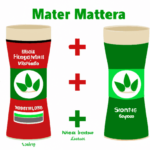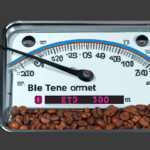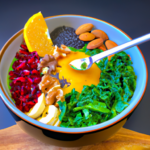Chia Seeds
Unlocking the Digestive Benefits of Tiny Powerhouses

We’ve uncovered a mystery tucked away in nature’s small but mighty sources of energy. Chia seeds, these modest yet remarkable spheres, are the secret to incredible benefits for digestion. They are miraculous for our intestinal health, encouraging proper function and easing uneasiness.
But that’s not all – chia seeds also improve nutrient absorption and support a healthy microbiome. Join us as we delve into the science behind these incredible seeds and learn how they can nourish and serve our bodies.
Key Takeaways
- Chia seeds are high in fiber, promoting a healthy digestive system.
- Chia seeds can aid in weight loss by expanding in the stomach and reducing appetite.
- Chia seeds can be used as a thickening agent in various recipes, such as soups and sauces.
- Chia seeds support improved nutrient absorption and contribute to a healthy gut microbiome.
Chia Seeds and Gut Health
Chia seeds contribute to improved gut health through their high fiber content and ability to promote healthy digestion. These tiny powerhouses are packed with fiber, which plays a crucial role in maintaining a healthy digestive system. Fiber adds bulk to the stool, preventing constipation and promoting regular bowel movements.
Additionally, chia seeds absorb water and form a gel-like substance in the gut, which helps to soften the stool and ease its passage through the intestines. This can be particularly beneficial for individuals struggling with constipation or irregular bowel movements.

Incorporating chia seeds into your diet isn’t only easy but also delicious. You can sprinkle them on top of yogurt or oatmeal, blend them into smoothies, or even use them as an egg substitute in baking. By incorporating chia seeds into your recipes, you can enhance the fiber content and promote a healthy gut, which may even aid in weight loss.
Transitioning into the subsequent section, let’s now explore how chia seeds can promote regularity in more detail.
Promoting Regularity With Chia Seeds
To promote regularity, incorporating chia seeds into our diet can be highly beneficial.
Chia seeds are packed with fiber, which is essential for maintaining a healthy digestive system. Consuming an adequate amount of fiber helps to prevent constipation and keeps the bowels moving smoothly.

Additionally, chia seeds have the ability to absorb water, forming a gel-like substance in the stomach. This gel-like substance adds bulk to the stool, making it easier to pass through the intestines.
Furthermore, chia seeds can aid in weight loss as they expand in the stomach, creating a feeling of fullness and reducing appetite.
To incorporate chia seeds into your diet, you can sprinkle them on top of salads, mix them into smoothies, or even use them as a replacement for eggs in baking recipes.
Soothing Digestive Discomfort With Chia Seeds
Continuing the discussion from the previous subtopic, incorporating chia seeds into our diet can also help soothe digestive discomfort. Chia seeds aren’t only rich in fiber, but they also contain essential nutrients that support healthy digestion. Here are some practical ways to incorporate chia seeds into your meals and alleviate digestive discomfort:

- Add chia seeds to smoothies or yogurt for a boost of fiber and omega-3 fatty acids.
- Make a chia seed pudding by mixing chia seeds with your favorite milk and letting it sit overnight.
- Use chia seeds as a thickening agent in soups, stews, and sauces.
- Sprinkle chia seeds on top of salads or roasted vegetables for added texture and nutritional benefits.
- Replace eggs in baking recipes with chia gel, made by combining chia seeds with water.
Incorporating chia seeds into your recipes not only supports digestive health but can also aid in weight loss due to their high fiber content. So why not give these tiny powerhouses a try and enjoy the soothing benefits they bring to your digestive system?
Chia Seeds and Improved Nutrient Absorption
Incorporating chia seeds into our diet further enhances digestive health by improving nutrient absorption. Not only are chia seeds packed with essential nutrients like omega-3 fatty acids, fiber, and protein, but they also have the ability to enhance our body’s ability to absorb these nutrients. This is great news for those looking to optimize their health and well-being.
When it comes to weight loss, chia seeds can be a valuable addition to your diet. The fiber content in chia seeds helps to keep you feeling full for longer, reducing the likelihood of overeating. Additionally, the combination of fiber and protein in chia seeds can help to stabilize blood sugar levels, preventing spikes and crashes that can lead to cravings and overeating.
Chia seeds are also beneficial for heart health. The omega-3 fatty acids found in chia seeds have been shown to reduce inflammation and lower the risk of heart disease. Additionally, the fiber content in chia seeds can help to lower cholesterol levels, further promoting heart health.

Incorporating chia seeds into our diet is a simple and effective way to improve nutrient absorption, support weight loss goals, and promote heart health. So why not start adding these tiny powerhouses to your meals and reap the digestive benefits they offer?
Supporting a Healthy Microbiome With Chia Seeds
As we delve into the benefits of chia seeds for digestive health, it’s important to explore how they support a healthy microbiome. Chia seeds aren’t only nutrient-dense, but they also contain a high amount of fiber, which plays a crucial role in promoting a healthy gut environment.
Here are five ways chia seeds support a healthy microbiome:
- Chia seeds and weight management: The high fiber content in chia seeds helps promote feelings of fullness, reducing the likelihood of overeating and aiding in weight management.
- Chia seeds and heart health: Chia seeds are rich in omega-3 fatty acids, which have been shown to reduce inflammation and lower the risk of heart disease.
- Prebiotic properties: Chia seeds contain prebiotic fibers that serve as food for beneficial gut bacteria, supporting their growth and diversity.
- Improved digestion: The soluble fiber in chia seeds helps regulate bowel movements and promotes regularity, preventing constipation and supporting a healthy digestive system.
- Reduced inflammation: Chia seeds are rich in antioxidants, which help reduce inflammation in the gut and support overall gut health.
Frequently Asked Questions
Can Chia Seeds Help With Weight Loss and Appetite Control?
Chia seeds can help with weight loss and appetite control. They are a great source of omega-3 fatty acids and can be used in various chia seed recipes. Incorporating chia seeds into your diet is a practical way to support your digestive health.

Are There Any Potential Side Effects or Risks Associated With Consuming Chia Seeds?
There may be potential allergic reactions and interactions with blood thinners associated with consuming chia seeds. It’s important to consider these risks before incorporating chia seeds into your diet.
How Should Chia Seeds Be Prepared and Consumed to Maximize Their Digestive Benefits?
To maximize the digestive benefits of chia seeds, we can prepare them in various delicious ways. Chia seed pudding is a popular recipe that not only tastes great but also helps support a healthy digestive system.
Can Chia Seeds Help With Conditions Like Irritable Bowel Syndrome (Ibs) or Inflammatory Bowel Disease (Ibd)?
Chia seeds for gut health and digestive disorders? Yes, chia seeds can help with conditions like irritable bowel syndrome (IBS) and inflammatory bowel disease (IBD). They are packed with fiber and omega-3 fatty acids, which promote healthy digestion and reduce inflammation in the gut.
Are There Any Specific Dietary Restrictions or Considerations for Individuals Incorporating Chia Seeds Into Their Diet for Digestive Health Purposes?
When incorporating chia seeds for digestive health, it’s important to consider dietary restrictions. We can explore chia seed recipes that are easy to make and tailored to individual needs, ensuring optimal digestive benefits.

Conclusion
In conclusion, incorporating chia seeds into your diet can provide numerous digestive benefits. From promoting regularity and soothing discomfort to improving nutrient absorption and supporting a healthy microbiome, these tiny powerhouses are a game-changer for gut health.
So why wait? Start adding chia seeds to your meals and experience the incredible transformation in your digestive system. It’s like unlocking a secret superpower that will leave you feeling invincible!
Hi, I’m Sarah. I write for Turtle Tree Seeds, a news blog that loves food – all kinds of food. But especially bacon, chocolate, and veggies. We’re on a mission to show the world that you can enjoy all of those things, even kale and brussels sprouts. Because we believe that when it comes to food, there’s no such thing as guilty pleasures. Just pleasures.
I’m also a huge fan of puns (obviously).
Commercial Production of Chia Seeds
Proven Techniques for High Yield Seed Harvesting

Did you know that using effective techniques for seed collection can significantly boost crop yields?
Translated in English (United States): Did you know that using effective techniques for seed collection can significantly boost crop yields?
In this article, we will explore proven methods to optimize your seed harvesting process.
From soil preparation and planting techniques to irrigation and pest control strategies, we will delve into the precise steps needed for high yield seed harvesting.
By implementing these techniques, you can improve your crop production and contribute to the liberation of sustainable agriculture.

Key Takeaways
- Crop rotation is essential for preventing pest and disease buildup and improving soil health.
- Cover crops help prevent soil erosion, improve soil structure, and increase organic matter content, enhancing soil fertility and productivity.
- Optimal planting and spacing methods, such as companion planting and crop rotation, contribute to higher yields and healthier plants.
- Efficient harvesting and seed processing methods, including proper seed storage and the use of state-of-the-art machinery, ensure maximum yield and high-quality seeds for customers.
Soil Preparation Techniques
Before we can achieve high yield seed harvesting, it’s essential that we properly prepare the soil using proven techniques.
Two key techniques that have proven effective in maximizing yield are crop rotation and cover crops.
Crop rotation involves systematically changing the type of crop grown in a particular field over multiple growing seasons. This technique helps prevent the buildup of pests and diseases that are specific to certain crops, thus reducing the need for chemical interventions. Additionally, crop rotation allows for the diversification of nutrients in the soil, leading to healthier plants and improved yield.
Cover crops, on the other hand, are planted to cover the soil during periods of fallow or between main crops. These crops help prevent soil erosion, improve soil structure, and increase organic matter content, ultimately enhancing the soil’s fertility and productivity.
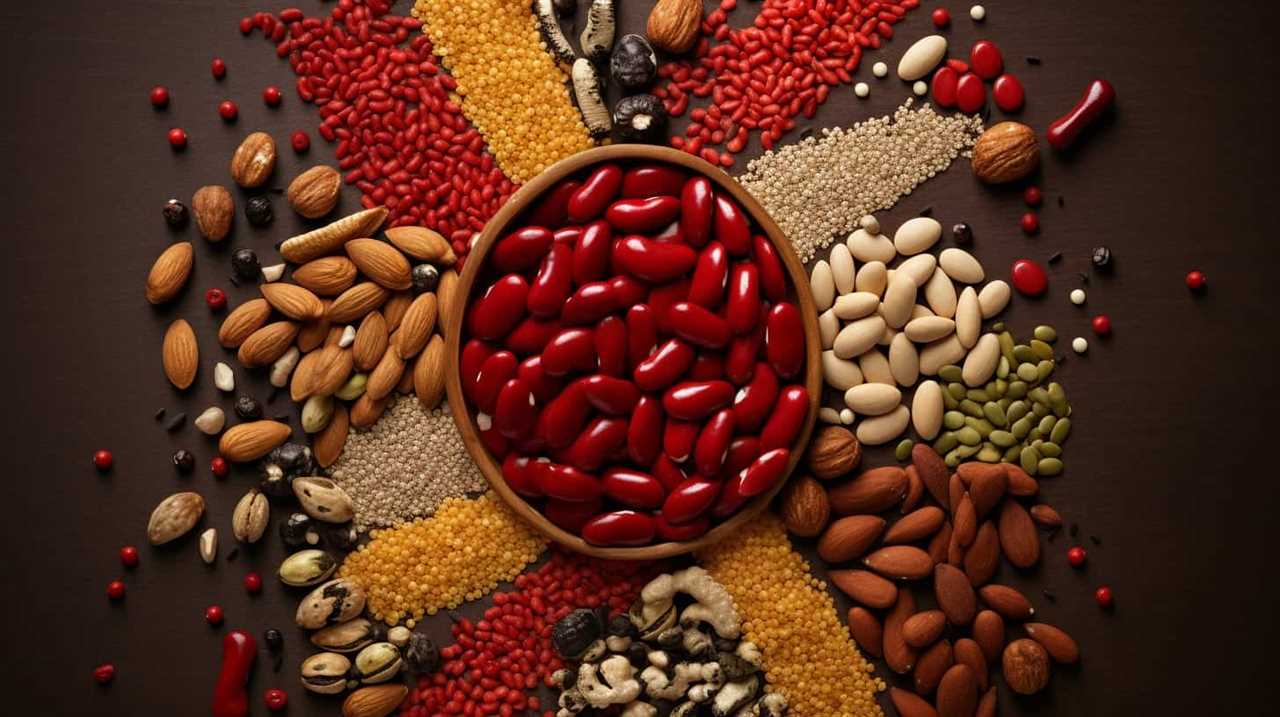
Optimal Planting and Spacing Methods
To achieve high yield seed harvesting, we implement optimal planting and spacing methods that maximize crop growth and yield. Two key techniques that contribute to this are companion planting and crop rotation. Companion planting involves planting different crops together that benefit each other, either by providing nutrients, repelling pests, or attracting beneficial insects. This symbiotic relationship helps to optimize plant growth and reduce the need for chemical inputs. On the other hand, crop rotation involves systematically changing the type of crop grown in a specific area over time. This helps to break pest and disease cycles, improve soil health, and prevent nutrient depletion. By implementing these techniques, we can ensure that our crops are planted and spaced optimally, leading to higher yields and healthier plants.
| Companion Planting | Crop Rotation |
|---|---|
| – Benefits: | – Benefits: |
| – Nutrient sharing | – Pest control |
| – Pest repellent | – Disease prevention |
| – Attracts beneficial insects | – Improves soil health |
| – Reduces chemical inputs | – Prevents nutrient depletion |
Effective Irrigation and Nutrient Management
Now, we continue our discussion by focusing on how we effectively manage irrigation and nutrients to maximize seed yield.
To achieve water conservation in seed production, we employ the following strategies:
- Drip irrigation: By delivering water directly to the root zone, we minimize evaporation and ensure efficient water usage.
- Mulching: Applying organic or synthetic materials around the plants reduces soil moisture evaporation and weed competition, promoting optimal water retention.
- Rainwater harvesting: We capture and store rainfall runoff for later use, reducing reliance on conventional water sources.
In addition to water management, crop rotation plays a crucial role in nutrient management. Here’s how we optimize nutrient levels:
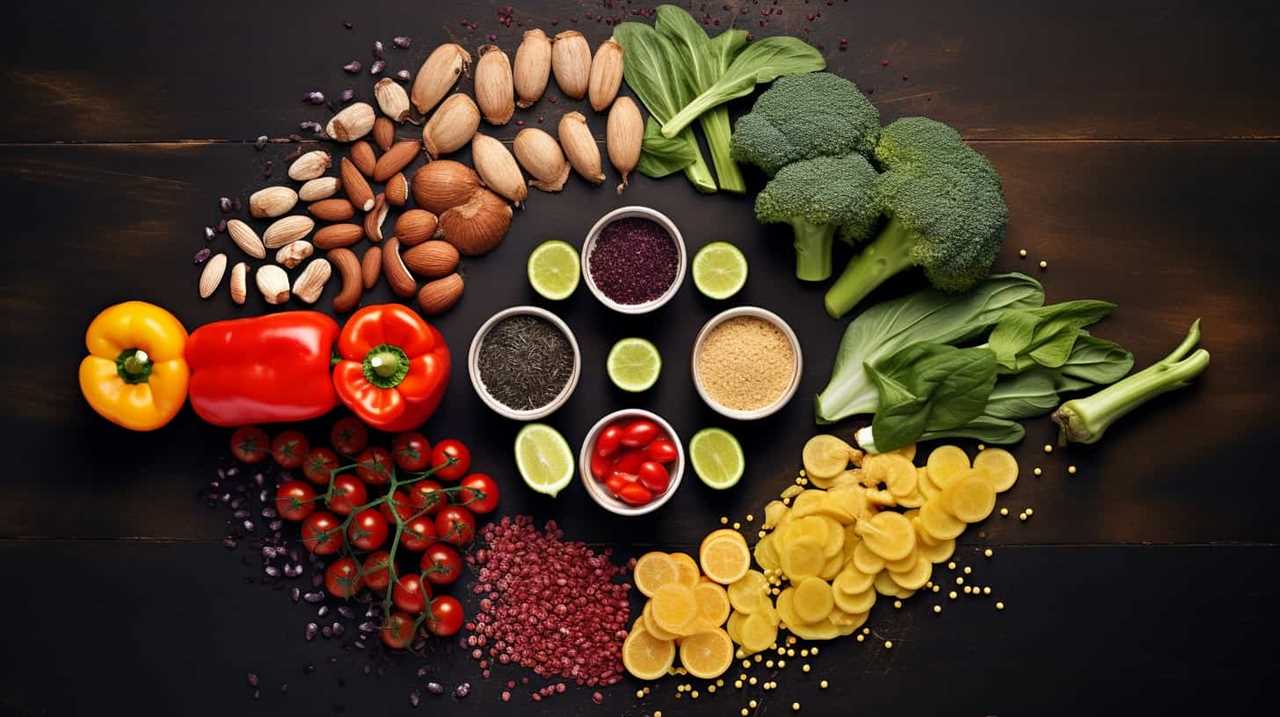
- Rotating crops: By alternating different plant species, we prevent nutrient depletion and reduce the risk of nutrient imbalances.
- Cover cropping: Growing cover crops between seed production cycles helps improve soil fertility and nutrient availability.
- Nutrient testing: Regular soil and tissue analysis allows us to identify nutrient deficiencies and tailor fertilizer application accordingly.
Pest and Disease Control Strategies
To effectively manage pest and disease control in our seed production, we employ proven strategies that prioritize proactive measures and regular monitoring. Integrated pest management (IPM) is a key approach we use, which focuses on preventing and managing pests through a combination of techniques. This includes cultural practices such as crop rotation and sanitation, as well as biological controls like the use of beneficial insects or nematodes. We also implement natural remedies, such as botanical extracts and microbial products, to control pests and diseases without relying solely on synthetic chemicals. By integrating these strategies into our seed production system, we are able to minimize the impact of pests and diseases on our crops, ensuring high-quality and healthy seeds for our customers.
| Pest and Disease Control Strategies |
|---|
| Integrated Pest Management |
| Natural Remedies |
| Proactive Measures |
| Regular Monitoring |
| Cultural Practices |
Efficient Harvesting and Seed Processing Methods
We employ efficient harvesting and seed processing methods to ensure maximum yield and quality. These methods include:
- Seed Storage Methods: We utilize proper storage techniques to maintain the viability of the harvested seeds. This involves storing seeds in a cool and dry environment, protecting them from pests and diseases, and avoiding exposure to excessive moisture or sunlight.
- Seed Viability Testing: Before storing the seeds, we conduct viability tests to determine their germination potential. This helps us identify the percentage of viable seeds and discard any non-viable ones. Various methods, such as the tetrazolium test or germination tests, are employed to assess seed viability accurately.
- Careful Cleaning and Sorting: We meticulously clean and sort the harvested seeds to remove any impurities, debris, or damaged seeds. This ensures that only high-quality seeds are stored for future use or distribution.
Conclusion
In conclusion, by implementing these proven techniques for high yield seed harvesting, we can cultivate a bountiful harvest that’s as fruitful as a lush garden in full bloom.
With the right soil preparation, planting and spacing methods, irrigation and nutrient management, as well as pest and disease control strategies, we can ensure optimal growth and vitality in our crops.

By employing efficient harvesting and seed processing methods, we can reap the rewards of our labor, like expert gardeners tending to their precious blossoms.
Hi, I’m Sarah. I write for Turtle Tree Seeds, a news blog that loves food – all kinds of food. But especially bacon, chocolate, and veggies. We’re on a mission to show the world that you can enjoy all of those things, even kale and brussels sprouts. Because we believe that when it comes to food, there’s no such thing as guilty pleasures. Just pleasures.
I’m also a huge fan of puns (obviously).
Chia Seeds in Weight Loss
9 Best Evidenced Outcomes of Weight Reduction With Tiny Seeds

Are you tired of struggling with weight loss? Imagine a solution that helps you shed the extra pounds while also offering numerous other health benefits. Look no further than these tiny seeds!
These little powerhouses of nutrition have been scientifically proven to aid in weight reduction. With increased feelings of fullness, reduced calorie intake, improved blood sugar control, enhanced metabolism, and decreased waist circumference, incorporating tiny seeds into your diet can be a game-changer on your weight loss journey.
Key Takeaways
- Tiny seeds have satiety effects, helping suppress appetite and increase feelings of fullness.
- Seeds promote satiety, reduce calorie intake, and aid in digestion, preventing bloating.
- Including seeds in the diet can lead to improved blood sugar control.
- Consuming seeds enhances metabolism, increases energy levels, and promotes fat burning.
Increased Feelings of Fullness
By consuming tiny seeds, you can experience increased feelings of fullness. These seeds have been found to have satiety effects, meaning they can help suppress your appetite and make you feel satisfied for longer periods of time. This is due to their high fiber content, which helps slow down the digestion process and keeps you feeling fuller for longer.
The seeds also contain healthy fats and protein, which further contribute to their satiating effects. Incorporating these tiny seeds into your diet can be a practical and effective way to control your appetite and manage your weight. Whether you sprinkle them on your salads, add them to your smoothies, or use them as a topping for your yogurt, these seeds can make a significant difference in promoting feelings of fullness and ultimately supporting your weight reduction goals.
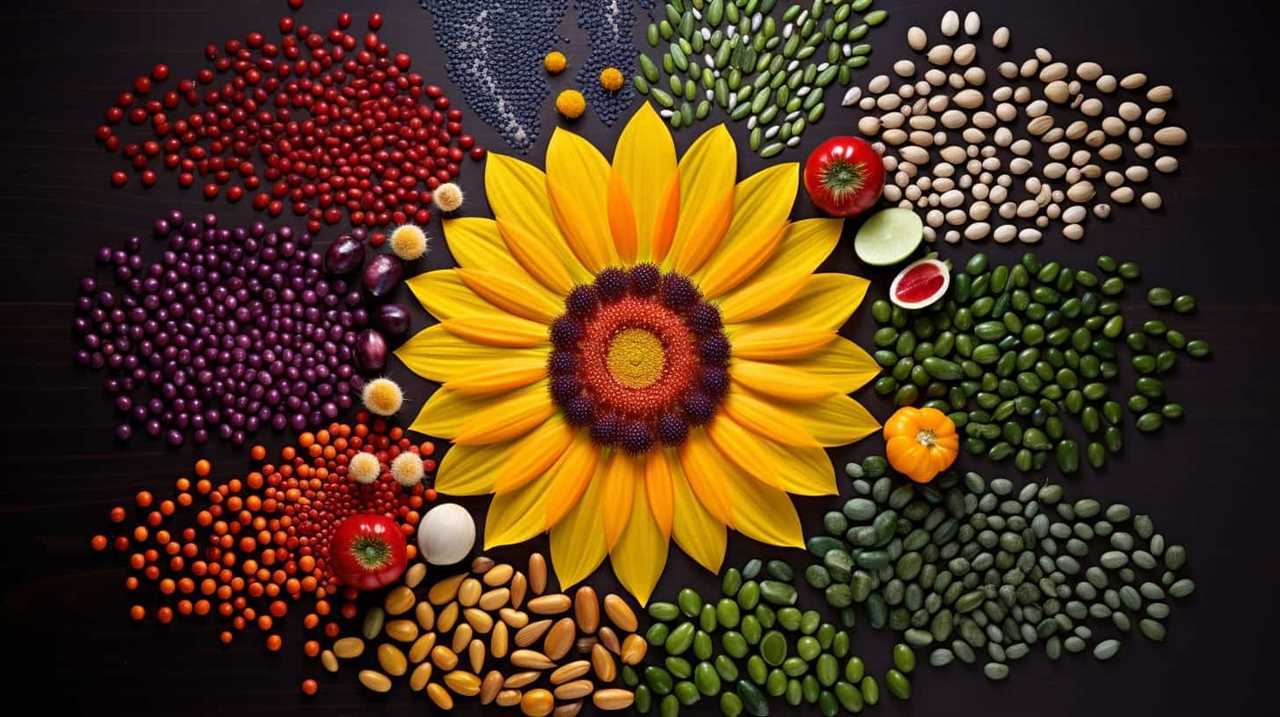
Reduced Calorie Intake
To further support your weight reduction goals, incorporating tiny seeds into your diet can also help you reduce your calorie intake. These little powerhouses are packed with fiber and healthy fats, which can increase satiety and keep you feeling full for longer periods of time. By adding seeds like chia, flax, or hemp to your meals and snacks, you can curb your hunger and prevent overeating.
Here are four ways that tiny seeds can improve your portion control and reduce your calorie intake:
- Sprinkle seeds on top of salads or yogurt to add a satisfying crunch and increase the overall volume of your meal.
- Blend seeds into smoothies or protein shakes to create a thicker texture that will keep you feeling satisfied.
- Use ground seeds as a substitute for breadcrumbs in recipes to decrease the calorie content without sacrificing flavor.
- Mix seeds into your favorite baked goods or oatmeal for added texture and a nutrient boost.
By incorporating these tiny seeds into your diet, you can improve portion control and reduce your calorie intake, supporting your weight reduction goals.
Next, let’s explore how these seeds can also contribute to improved blood sugar control.

Improved Blood Sugar Control
To achieve improved blood sugar control, it’s important that you incorporate tiny seeds into your diet.
Tiny seeds, such as chia seeds and flaxseeds, have been shown to have long-term effects on blood sugar regulation.
These seeds are rich in fiber and healthy fats, which can help slow down the absorption of glucose in the bloodstream.
Additionally, they’ve a low glycemic index, meaning they’ve a minimal impact on blood sugar levels.
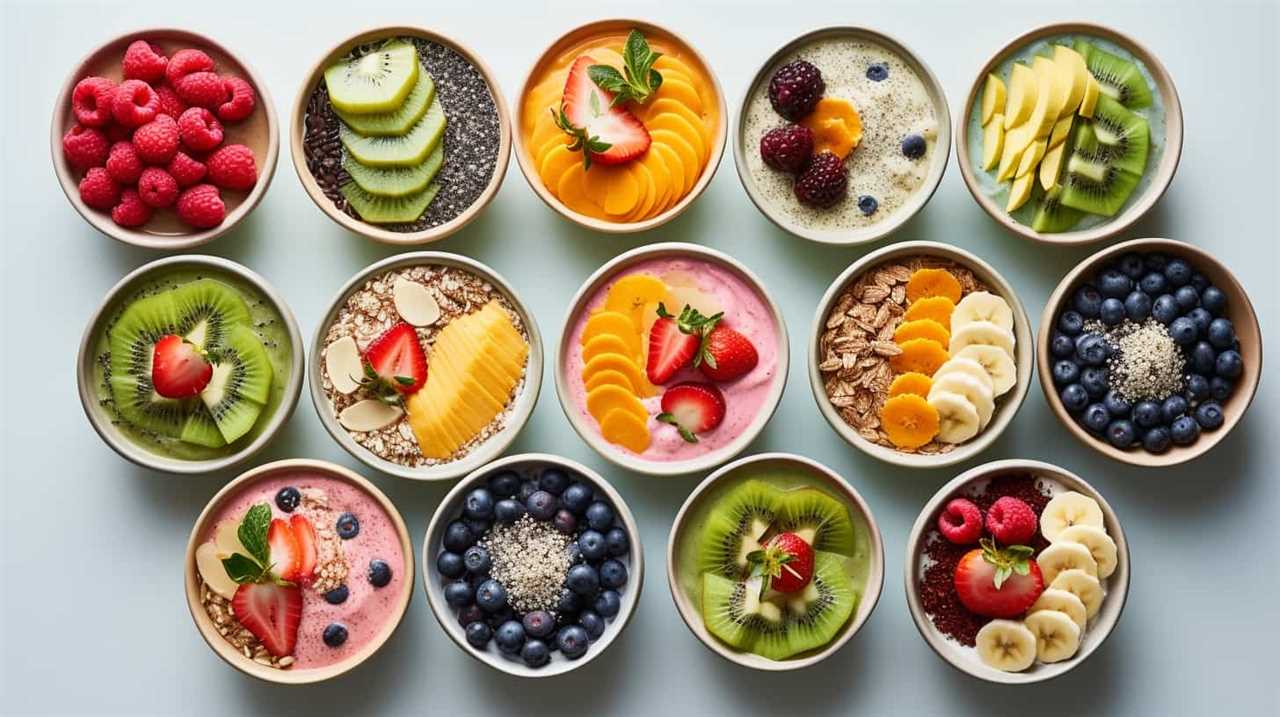
The high fiber content in these seeds also contributes to improved insulin sensitivity, allowing your body to utilize insulin more effectively.
Enhanced Metabolism
Including tiny seeds in your diet can enhance your metabolism. Here are four ways these seeds can boost energy levels and increase fat burning:
-
Chia seeds: These tiny powerhouses are packed with fiber, protein, and omega-3 fatty acids. They can help regulate blood sugar levels and improve digestion, leading to increased energy and fat burning.
-
Flaxseeds: Rich in fiber and healthy fats, flaxseeds can promote satiety and curb cravings. They also contain lignans, which have been shown to support weight loss and improve metabolic health.

-
Pumpkin seeds: These seeds are a great source of magnesium, which plays a crucial role in energy production and metabolism. By including pumpkin seeds in your diet, you can support optimal metabolic function.
-
Sesame seeds: High in antioxidants and healthy fats, sesame seeds can help increase thermogenesis, the process by which your body burns calories to produce heat.
By incorporating these tiny seeds into your diet, you can enhance your metabolism, increase energy levels, and promote fat burning.
This improved metabolic function sets the stage for the next section, where we’ll discuss the impact of these seeds on decreased waist circumference.

Decreased Waist Circumference
By including these tiny seeds in your diet, you can experience a reduction in waist circumference. Decreased waist circumference is one of the key outcomes of weight loss and improved body composition.
When you consume these seeds, they can contribute to weight loss by promoting satiety and reducing overall calorie intake. Additionally, these seeds are rich in fiber, which can aid in digestion and prevent bloating, resulting in a slimmer waistline.
The high nutrient content of these seeds can also support muscle growth and development, which can further contribute to a reduction in waist circumference.
Incorporating these tiny seeds into your diet is a practical and effective way to achieve your weight loss goals and improve your body composition.

Frequently Asked Questions
Are There Any Potential Side Effects or Risks Associated With Consuming Tiny Seeds for Weight Reduction?
There may be potential risks and safety concerns associated with consuming tiny seeds for weight reduction. It is important to be aware of the weight loss hazards, health risks, and potential side effects.
How Long Does It Typically Take to See Noticeable Results in Weight Reduction When Incorporating Tiny Seeds Into the Diet?
On average, it takes a few weeks to start noticing weight reduction when you incorporate tiny seeds into your diet. The benefits of including these seeds are numerous, making it a practical choice for those looking to serve their weight loss goals.
Are There Any Specific Types of Tiny Seeds That Are More Effective for Weight Reduction Than Others?
Chia seeds are effective for weight reduction due to their high fiber and protein content. Flaxseed consumption can also impact weight loss progress by promoting feelings of fullness. Incorporating these tiny seeds into your diet can be a practical way to support your weight loss goals.
Can Tiny Seeds Be Used as a Standalone Weight Loss Method, or Should They Be Combined With Other Lifestyle Changes Such as Exercise and a Balanced Diet?
To achieve the best weight reduction outcomes, it is advisable to combine tiny seeds with other lifestyle changes such as exercise and a balanced diet. While tiny seeds can be effective as a standalone method, the combination yields superior results.
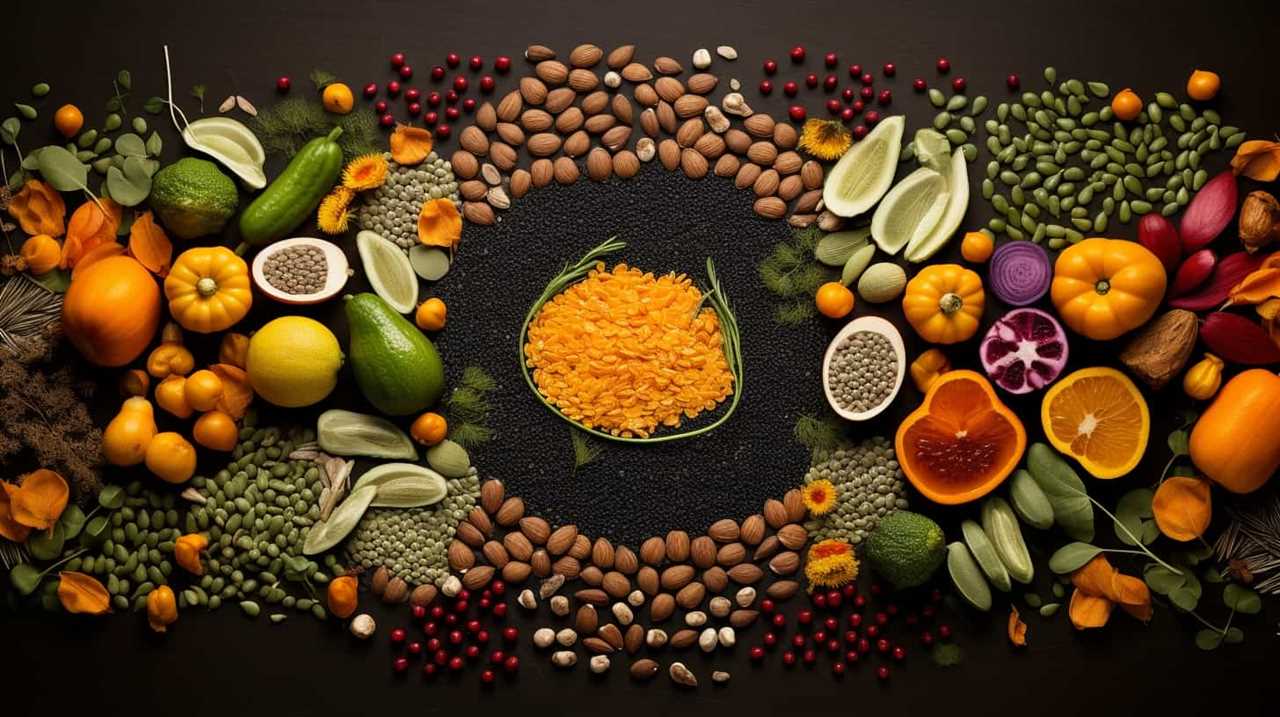
Are There Any Specific Recommendations for the Dosage or Frequency of Consuming Tiny Seeds for Optimal Weight Reduction Results?
For optimal weight reduction results, it is important to consider dosage recommendations and the optimal frequency of consuming tiny seeds. Taking the right amount at the right time can help you achieve your goals.
Conclusion
In conclusion, the evidence strongly supports the positive outcomes of weight reduction with tiny seeds. These seeds have been shown to increase feelings of fullness, reduce calorie intake, improve blood sugar control, enhance metabolism, and decrease waist circumference.
Incorporating these seeds into your diet can have practical benefits for weight management and overall health. So, why wait? Start reaping the benefits of these tiny powerhouses today and take control of your weight and well-being.
Hi, I’m Sarah. I write for Turtle Tree Seeds, a news blog that loves food – all kinds of food. But especially bacon, chocolate, and veggies. We’re on a mission to show the world that you can enjoy all of those things, even kale and brussels sprouts. Because we believe that when it comes to food, there’s no such thing as guilty pleasures. Just pleasures.
I’m also a huge fan of puns (obviously).
Historical Use of Chia Seeds
Seeds of Antiquity: A Forgotten Nutritional Powerhouse

Deep within the depths of forgotten history lies a hidden gem waiting to be uncovered – the chia seed. We, the seekers of knowledge, have embarked on a journey to unravel the mysteries of this ancient superfood.
Through the annals of time, chia seeds have nourished civilizations, from the Mayans to the Aztecs, serving as a staple food and a source of sustenance.
Join us as we delve into the traditional uses and fascinating history of these seeds, unlocking their secrets for the benefit of all.
Key Takeaways
- Chia seeds were valued by ancient civilizations like the Egyptians, Chinese, Mayans, and Aztecs for their high nutritional value and health benefits.
- Chia seeds are rich in omega-3 fatty acids, fiber, protein, and antioxidants, and contain essential minerals like calcium, magnesium, and phosphorus.
- Chia seeds have various culinary uses, such as being used as an egg substitute in baking, sprinkled on top of dishes for added crunch, and used as a thickening agent in soups and dressings.
- Chia seeds have a rich cultural heritage and have been used for their medicinal properties throughout history. They are also considered a sustainable crop with a low environmental impact.
Ancient Civilizations and Chia Seeds
We discovered that ancient civilizations prominently utilized chia seeds for their nutritional benefits. In ancient Egypt, chia seeds played a significant role in their diet, providing a rich source of essential nutrients and energy. The Egyptians recognized the remarkable health benefits of chia seeds, incorporating them into their daily meals. These tiny seeds were valued for their high protein content, omega-3 fatty acids, and fiber, which supported digestion and promoted overall well-being.
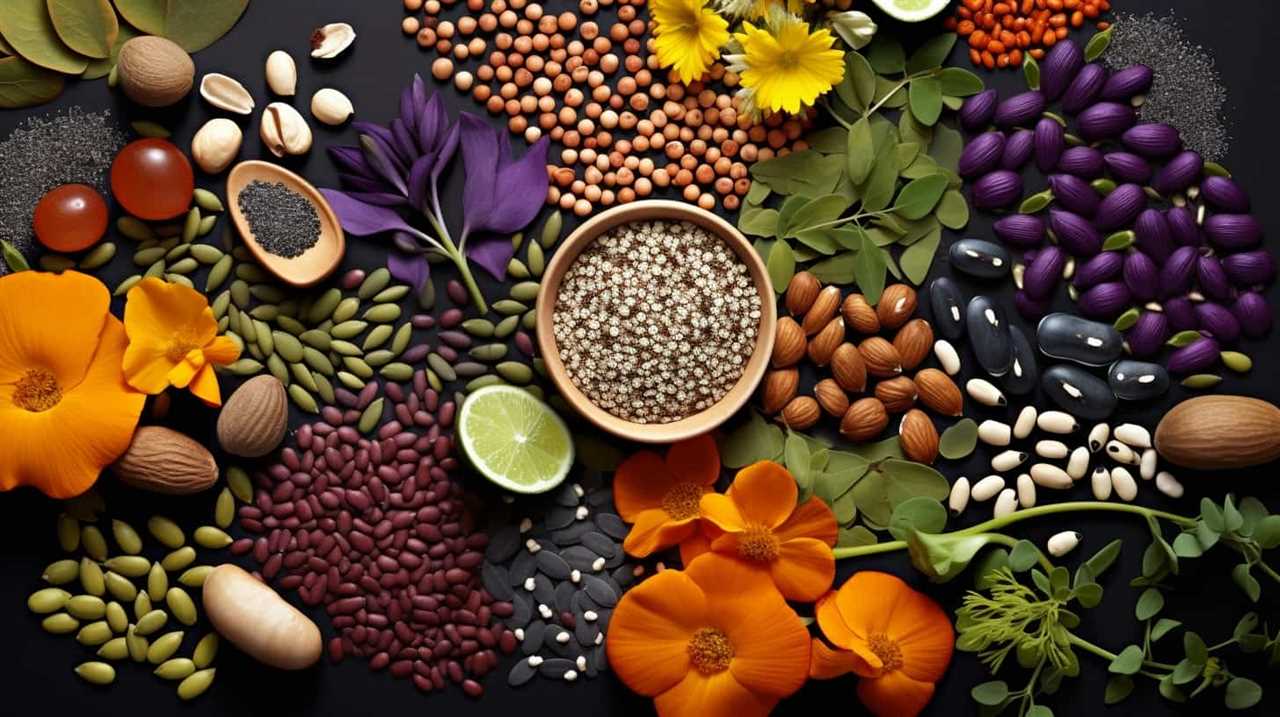
Similarly, in ancient Chinese culture, chia seeds were highly regarded for their medicinal properties. Traditional Chinese medicine recognized the seeds’ ability to nourish the body, improve digestion, and boost vitality. Chia seeds were often used to alleviate digestive issues, reduce inflammation, and enhance cardiovascular health. Their natural antioxidant properties were also utilized to support the immune system and promote longevity.
The ancient civilizations of Egypt and China recognized the immense value of chia seeds, harnessing their nutritional and medicinal properties to serve the well-being of their people. Today, we can continue to benefit from the wisdom of these ancient cultures by incorporating chia seeds into our own diets for optimal health and vitality.
Chia Seeds in Mayan Cuisine
In Mayan cuisine, chia seeds were a staple ingredient, providing a rich source of essential nutrients and contributing to overall health and vitality. Chia seeds were considered one of the Mayan superfoods due to their high nutritional value. These tiny seeds weren’t only abundant in protein, fiber, and healthy fats, but they also contained important vitamins and minerals such as calcium, phosphorus, and magnesium.
Mayans incorporated chia seeds into their meals in various ways. They’d mix the seeds with water or fruit juice, creating a nutritious beverage known as ‘chia fresca.’ Chia seeds were also used as a thickening agent in soups and stews, adding a unique texture and enhancing the nutritional content of the dishes.
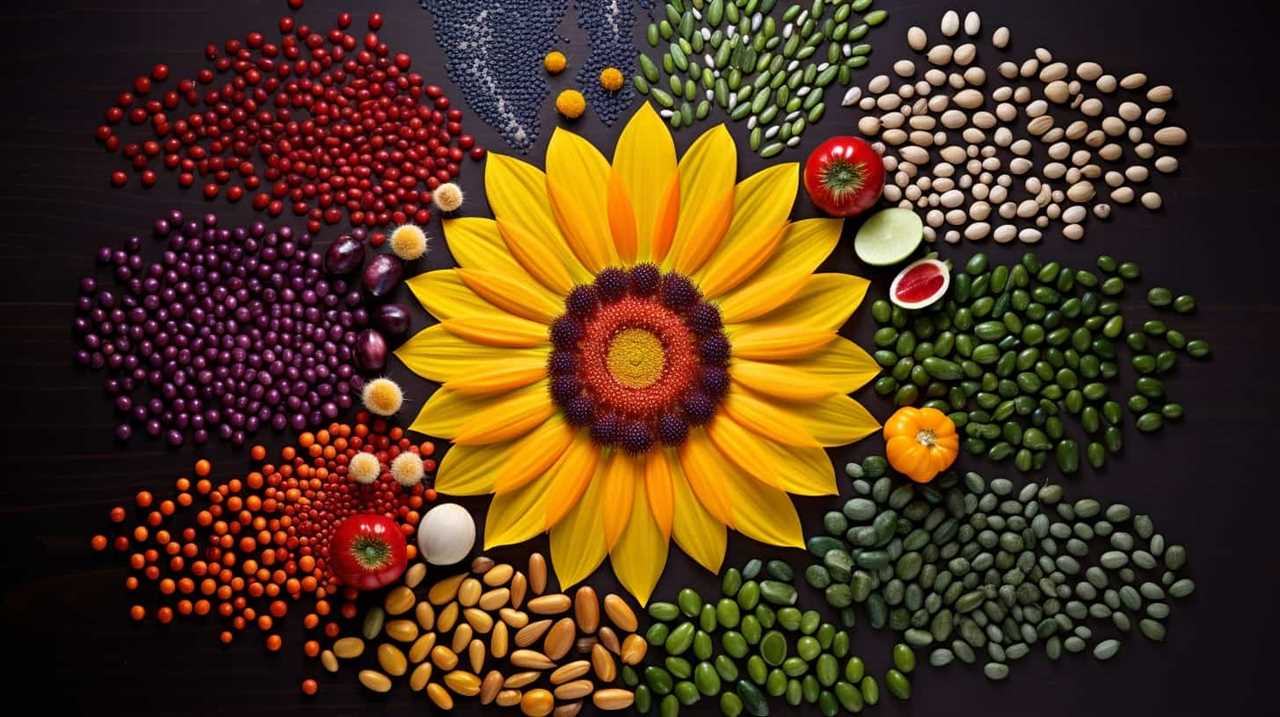
Today, we can still enjoy the benefits of chia seeds by incorporating them into our own recipes for a healthy and fulfilling diet.
Chia Seeds in Aztec Culture
Chia seeds played a significant role in Aztec culture, being widely utilized for their nutritional benefits and incorporated into various aspects of daily life. These Aztec superfoods were highly valued for their ability to provide sustained energy and nourishment.
Here are two ways in which chia seeds were deeply intertwined with Aztec society:
- Culinary Delicacies: Chia seeds were a staple ingredient in Aztec cuisine, used in a variety of dishes such as atole, a thickened beverage, and tamales, a popular corn-based dish. Their gelatinous texture when soaked in water added a unique element to these traditional recipes, enhancing both taste and nutritional value.
- Religious Rituals: Chia seeds held spiritual significance for the Aztecs, often used as offerings in sacred ceremonies. The seeds were believed to possess mystical properties that connected the physical and spiritual realms, symbolizing fertility, abundance, and the cycle of life.
The Aztecs recognized the immense nutritional benefits of chia seeds, incorporating them into their daily lives and embracing their status as an Aztec superfood.
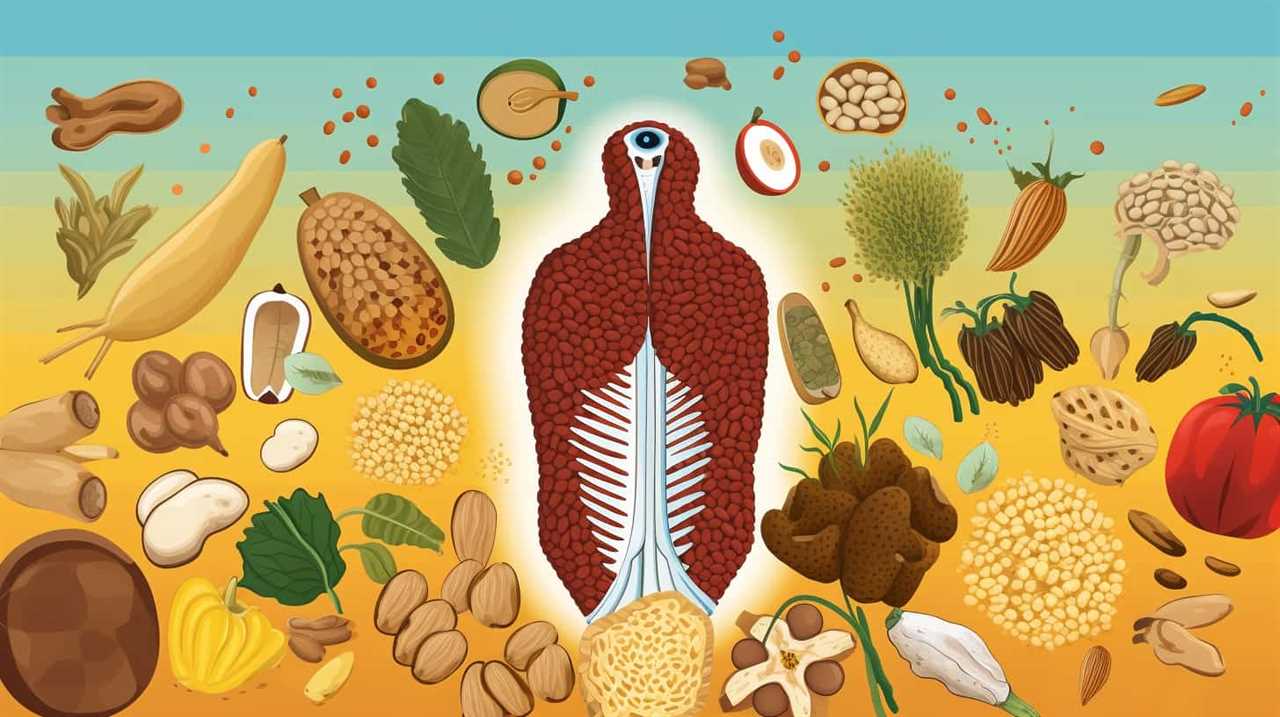
Chia Seeds as a Staple Food
After delving into the role of chia seeds in Aztec culture, we now turn our attention to their significance as a staple food.
Chia seeds have long been recognized for their exceptional nutritional benefits. Packed with omega-3 fatty acids, fiber, protein, and antioxidants, these tiny seeds offer a wealth of health-promoting properties. In fact, chia seeds are considered one of nature’s superfoods due to their high nutrient content. They’ve been associated with improved heart health, digestion, and weight management.
Additionally, chia seeds can be incorporated into a variety of modern recipes, from smoothies and puddings to baked goods and salads. With their mild, nutty flavor, they add a delightful crunch and nutritional boost to any dish.
As we explore the traditional uses of chia seeds, we’ll see how their versatility extends beyond their nutritional value.
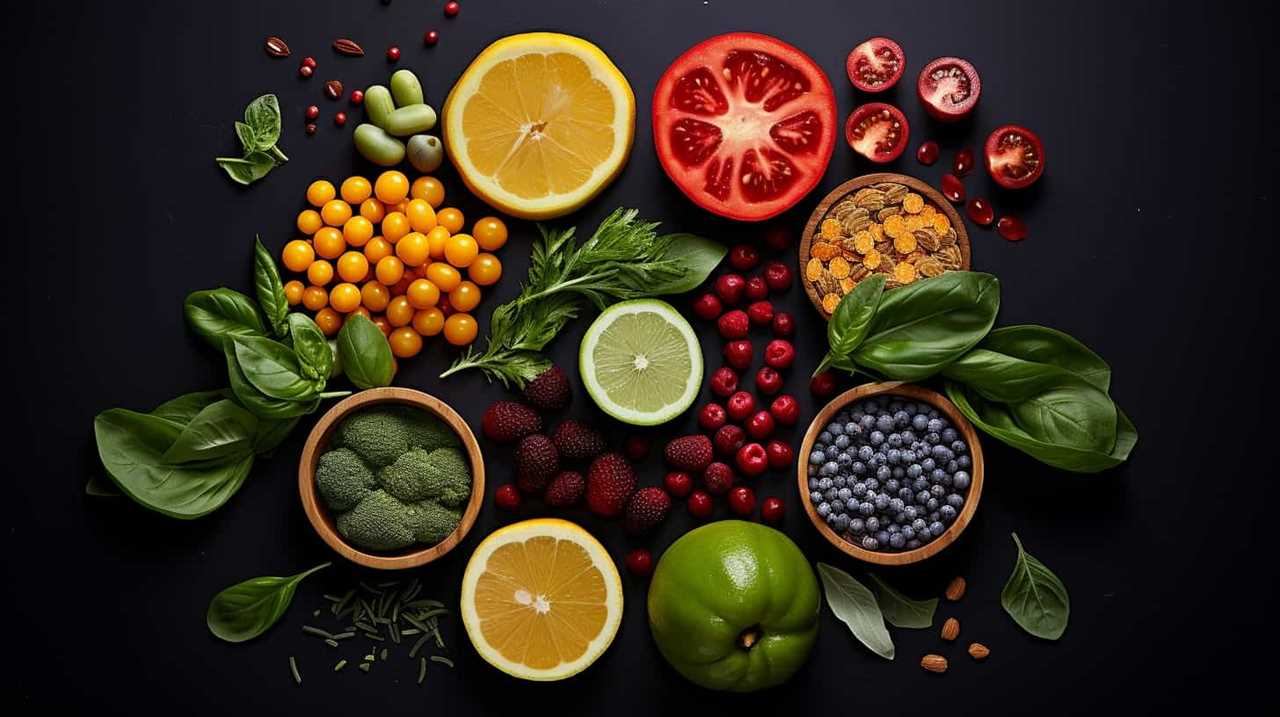
Traditional Uses of Chia Seeds
Our exploration of chia seeds’ traditional uses unveils the myriad ways this nutritional powerhouse has been incorporated into daily life.
Throughout history, chia seeds have been revered for their medicinal properties and have been used in various remedies and treatments. Ancient civilizations believed that chia seeds had the power to heal and strengthen the body, making it a staple in traditional medicine. Today, we continue to harness the medicinal properties of chia seeds in the form of herbal teas, tinctures, and poultices.
Additionally, chia seeds are a versatile ingredient in many recipes, adding a healthy boost of nutrients and a delightful texture. From smoothies and puddings to breads and salads, there are countless chia seed recipes that can be enjoyed as part of a balanced and nourishing diet.
Frequently Asked Questions
Are There Any Side Effects or Potential Risks Associated With Consuming Chia Seeds?
There can be potential risks associated with consuming chia seeds, such as bloating, digestive issues, and allergic reactions. Long term effects of chia seed consumption are still being studied, so it’s important to consume them in moderation.
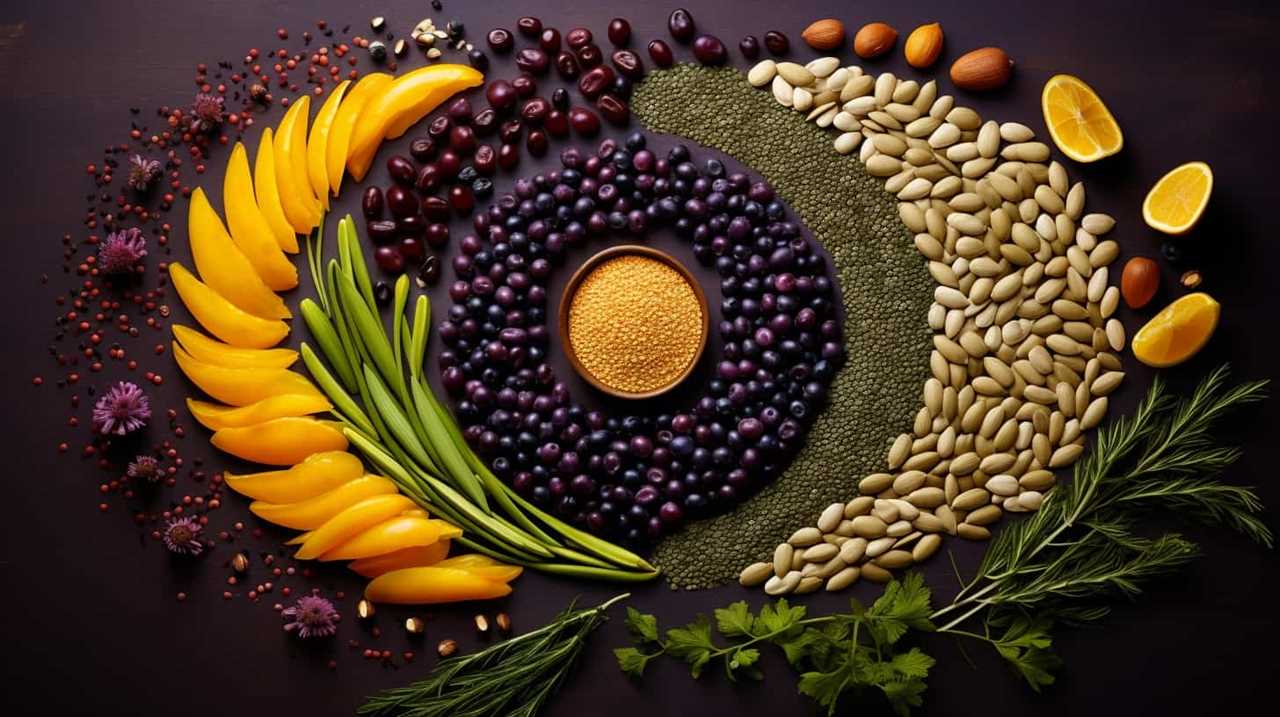
How Can Chia Seeds Be Incorporated Into Modern Diets and Recipes?
Incorporating chia seeds into modern diets can be done in various creative ways. From adding them to smoothies and yogurt to using them as a substitute for eggs in baking, there are endless possibilities for incorporating this nutritional powerhouse into your daily meals.
What Is the Nutritional Content of Chia Seeds and How Do They Compare to Other Superfoods?
Chia seeds are a nutritional powerhouse, offering a wide range of health benefits. Compared to flaxseeds, they provide more omega-3 fatty acids, making them an excellent plant-based source. Incorporating chia seeds into our diets can greatly improve our overall well-being.
Can Chia Seeds Aid in Weight Loss or Provide Other Health Benefits?
Chia seeds can aid in weight loss and provide various health benefits. They impact digestion and gut health by promoting regularity and reducing inflammation. They also improve cardiovascular health by lowering cholesterol and blood pressure.
Where Can I Buy Chia Seeds and Are There Different Varieties Available?
We can find chia seeds at various stores and online retailers. There are different types of chia seeds available, such as black and white. Let’s explore the buying options and the varieties in more detail.
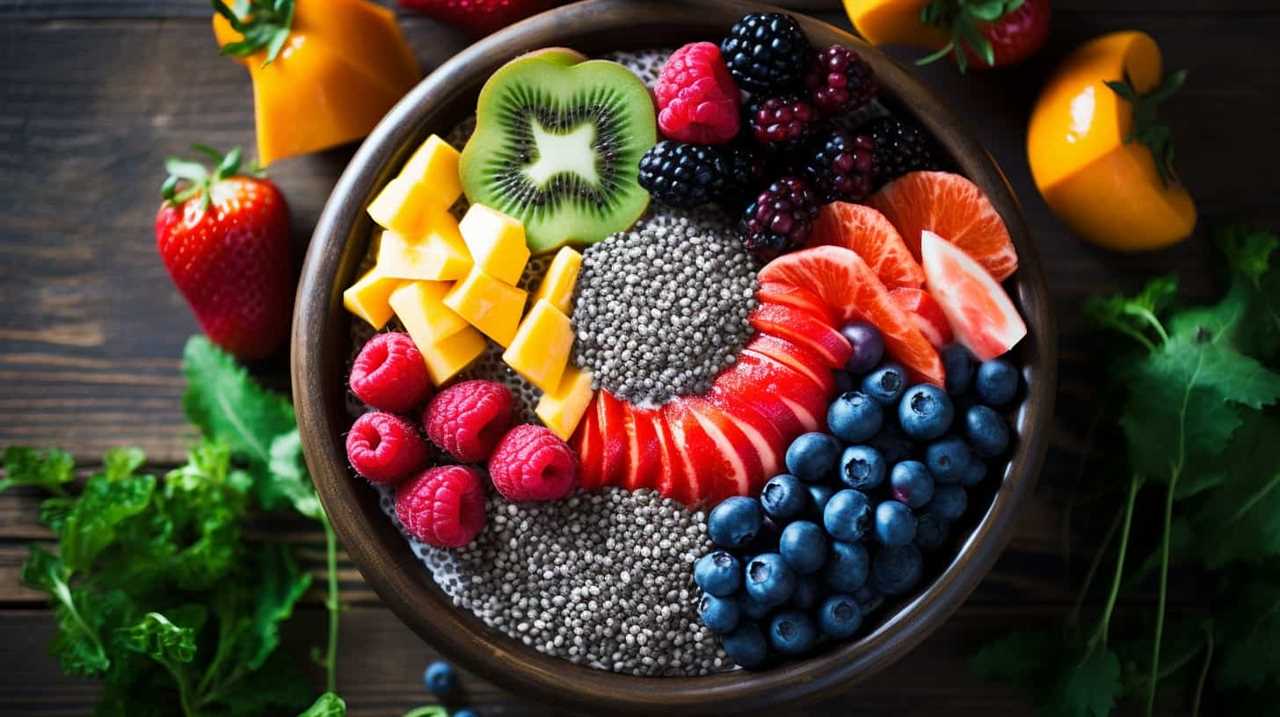
Conclusion
In conclusion, chia seeds have long been a nutritional powerhouse in ancient civilizations such as the Mayans and Aztecs. Despite their small size, these seeds were a staple food due to their high nutrient content and numerous health benefits.
While some may argue that chia seeds are just a trendy superfood, their historical significance and traditional uses prove otherwise. Incorporating chia seeds into our modern diets can provide us with a rich source of essential nutrients and contribute to our overall well-being.
Hi, I’m Sarah. I write for Turtle Tree Seeds, a news blog that loves food – all kinds of food. But especially bacon, chocolate, and veggies. We’re on a mission to show the world that you can enjoy all of those things, even kale and brussels sprouts. Because we believe that when it comes to food, there’s no such thing as guilty pleasures. Just pleasures.
I’m also a huge fan of puns (obviously).
-
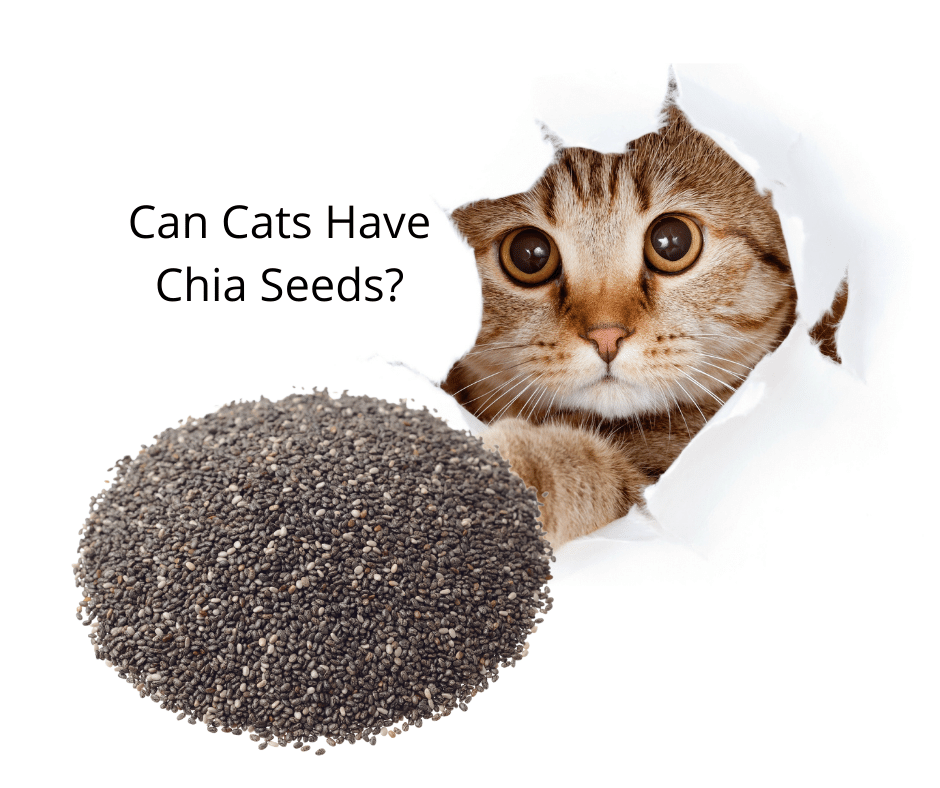
 Chia Seeds3 months ago
Chia Seeds3 months agoCan Cats Have Chia Seeds?
-
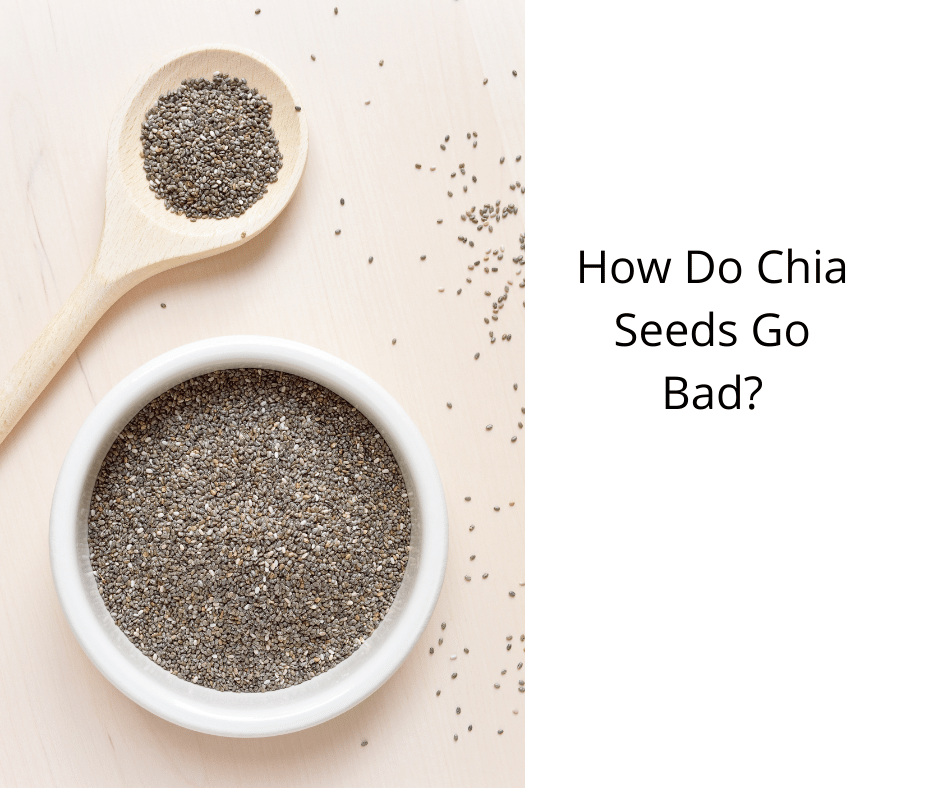
 Chia Seeds3 months ago
Chia Seeds3 months agoHow Do Chia Seeds Go Bad?
-

 Chia Seeds3 months ago
Chia Seeds3 months agoDo Chia Seeds Make You Poop?
-

 Health Risks and Allergies Related to Chia Seeds3 months ago
Health Risks and Allergies Related to Chia Seeds3 months agoWhy Do Chia Seeds Gel
-

 Chia Seeds3 months ago
Chia Seeds3 months agoHow to Use Chia Seeds For Weight Loss
-

 Chia Seeds and Digestive Health2 weeks ago
Chia Seeds and Digestive Health2 weeks agoWhy Are Chia Seeds Beneficial For Gut Health?
-
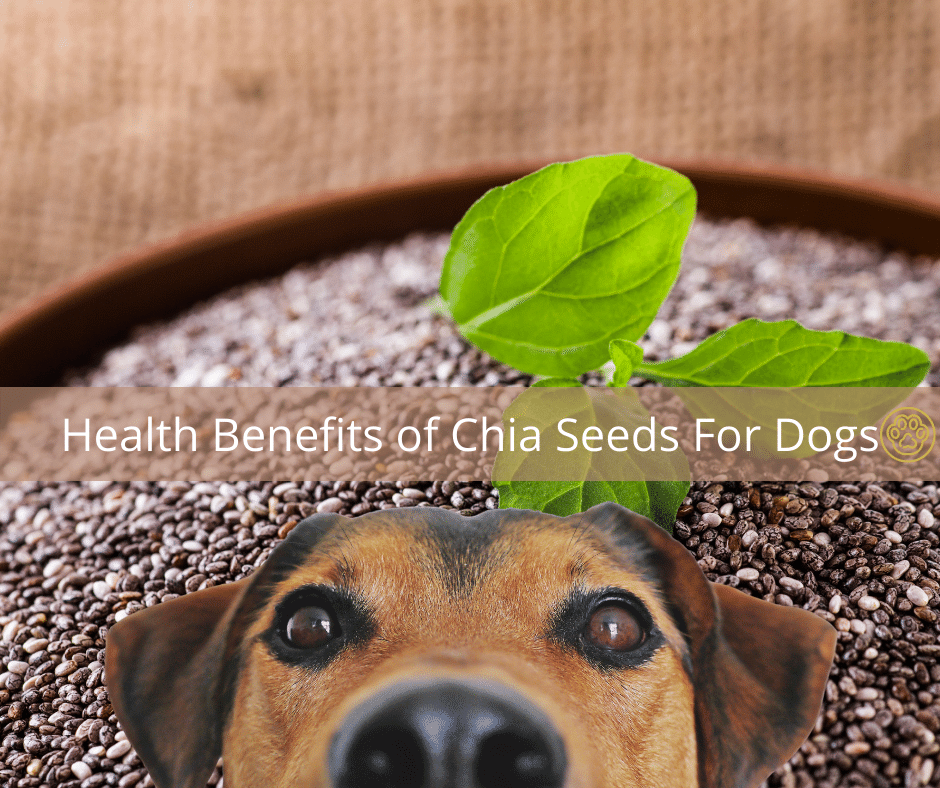
 Chia Seeds3 months ago
Chia Seeds3 months agoHealth Benefits of Chia Seeds For Dogs
-
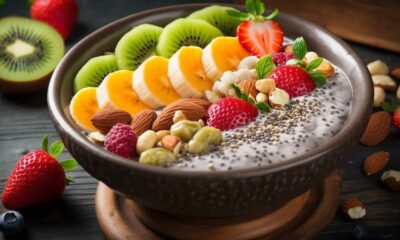
 Chia Seeds in Gluten-Free Diets2 months ago
Chia Seeds in Gluten-Free Diets2 months agoYour Dependable Guide: Chia as a Gluten Substitute






